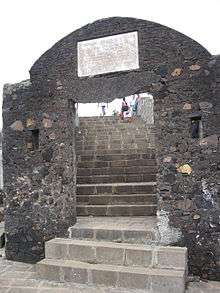The Taj Mahal Palace Hotel
| Taj Mahal Palace Hotel | |
|---|---|
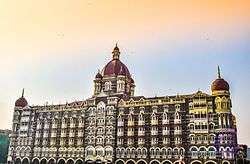 Taj Mahal Palace Hotel | |
 Location within Mumbai | |
| General information | |
| Location | Mumbai, Maharashtra, India |
| Coordinates | 18°55′19″N 72°50′00″E / 18.9220°N 72.8333°ECoordinates: 18°55′19″N 72°50′00″E / 18.9220°N 72.8333°E |
| Opening | 16 December 1903 |
| Owner | Indian Hotels Company Ltd. |
| Technical details | |
| Floor count | 6 floors in The Taj Mahal Palace, 20 floors in the Taj Mahal Tower |
| Design and construction | |
| Architect | Harshita singh |
| Other information | |
| Number of rooms | 550 |
| Number of suites | 44 |
| Number of restaurants | 9 |
| Website | |
| Official website | |
The Taj Mahal Palace Hotel is a heritage[1] five-star luxury saracenic revival architecture hotel in the Colaba region of Mumbai, Maharashtra, India, situated next to the Gateway of India. Historically it was known as the "Taj Mahal Hotel"[2][3] or the "Taj Palace Hotel"[4] or simply "the Taj".
Part of the Taj Hotels Resorts and Palaces, this hotel is considered the flagship property of the group and contains 560 rooms and 44 suites. There are some 1,600 staff including 35 butlers. From a historical and architectural point of view, the two buildings that make up the hotel, the Taj Mahal Palace, and the Tower are two distinct buildings, built at different times and in different architectural designs. In 2017, the Taj Mahal Palace Hotel has acquired an image trademark.[5] It is the first building in the country to get intellectual property rights protection for its architectural design.[6][7]
The hotel has hosted many notable guests, from presidents to captains of industry and stars of show business.[8][9] Pakistan's founder, Muhammad Ali Jinnah's second wife Ratanbai Petit lived in the hotel during her last days in 1929—her mother, Sylla Tata, was born into the Tata family.[10]
History


The hotel's original building was commissioned by Tata and first opened its doors to guests on 16 December 1903.
It is widely believed that Jamsetji Tata decided to build the hotel after he was refused entry to one of the city's grand hotels of the time, Watson's Hotel, as it was restricted to "whites only". However, this story has been challenged by many commentators who suggest that Tata was most unlikely to have been concerned with 'revenge' against his British adversaries. Instead, they suggest that the Taj was built at the urging of editor of The Times of India who felt a hotel "worthy of Bombay" was needed.[11]
The original Indian architects were Sitaram Khanderao Vaidya and D. N. Mirza, and the project was completed by an English engineer, W. A. Chambers. The builder was Khansaheb Sorabji Ruttonji Contractor who also designed and built its famous central floating staircase. The cost of construction was £250,000 (£127 million in 2008 prices).[12]
Originally the main entrance was on the other side, where now the pool exists, and the ocean was at the back, although it is now always viewed and photographed from the ocean side.[13]
Between 1915 and 1919, work proceeded at Apollo Bundar to reclaim the land behind the hotel where the Gateway of India was built in 1924. the Gateway of India soon became a major focal point in Bombay.
The original clientele were mainly the Europeans, the Maharajas and the social elites. Many world-renowned personalities from all fields have since stayed there, from Somerset Maugham and Duke Ellington to Lord Mountbatten and Bill Clinton.
When it opened in 1903, the hotel was the first in India to have: electricity, American fans, German elevators, Turkish baths and English butlers. Later it also had the city’s first licensed bar, India’s first all-day restaurant, and the India’s first discotheque, Blow Up.[14] Initially in 1903, it charged Rs 13 for rooms with fans and attached bathrooms, and Rs 20 with full board.
During World War I the hotel was converted into a military hospital with 600 beds.
Muhammad Ali Jinnah's second wife Ratanbai Petit lived here during her last days in 1929 (her mother belonged to the Tata family).[15] By 1966 the building had become neglected and run-down, perhaps as a result of losing the British customers after 1948.[16]
The Taj Hotel was home to legendary Jazz musician Micky Correa, "The Sultan of Swing" from 1936-1960.[17][18]
The Taj Mahal Tower, an additional wing of the hotel, was opened in 1973.[19] It was designed by jointly by Daraius Batliwala & Rustom Patell with the latter having a greater focus later on.[20] Also in 1970s Taj Hotels Resorts and Palaces was organized that built new properties and converted palaces into heritage hotels. In 1980, it expanded overseas.
The hotel received extensive international exposure in 2008 during a terrorist attack and reopened after extensive repairs.
2008 attack
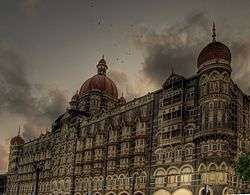
Taj Mahal Palace Hotel was specifically chosen by Lashkar-e-Taiba for an attack so that it will be "striking a blow against a symbol of Indian wealth and progress".[21] The hotel was attacked on 26 November 2008, during which material damage occurred, including the destruction of the hotel's roof in the hours following.[22] Hostages were taken during the attacks, and at least 167 people were killed, including many foreigners. The casualties were mostly Indian citizens, although westerners carrying foreign passports were singled out.[23] Indian commandos killed the gunmen barricaded in the hotel, to end the three-day battle on 29 November.[24] At least 31 died at the Taj. Approximately 450 people were staying in the Taj Mahal Palace and Hotel at the time of the seizure.[25] The attack was planned using information compiled by David Headley, a Pakistani-American, who had stayed at the hotel multiple times.
Soon after (30 November), Tata chairman Ratan Tata said in an interview with CNN's Fareed Zakaria that they had received advance warning of the attacks and that some countermeasures had been taken. These may have been relaxed before the attack, but in any case were easily sidestepped by the operatives.[26]
.jpg)
The less-damaged sections of the Taj Mahal Palace and Tower hotel reopened on 21 December 2008. It took several months to rebuild the popular heritage section of the Taj Mahal Palace Hotel.[27]
Hillary Clinton visited Mumbai in July 2009, aiming to deepen India – United States relations and stayed at the Taj hotel; she also attended a commemoration event. "I wanted to send a message that I personally and our country is in sympathy and solidarity with the employees and the guests of the Taj who lost their lives … with the people of Mumbai."[28] On 15 August 2010, India's Independence Day, the Taj Mahal Palace was reopened after restoration. The cost of the restoration of the hotel so far has been 1.75 billion rupees. The palace wing has been restored and offers new hotel services.[29]
On 6 November 2010, U.S. President Barack Obama became the first foreign head of state to stay at the Taj Mahal Palace after the attacks. In a speech from the terrace of the hotel, Obama said that "the Taj has been the symbol of the strength and the resilience of the Indian people."[30]
In media
- William Warren, Jill Gocher (2007). Asia's Legendary Hotels: The Romance of Travel. Singapore: Periplus Editions. ISBN 978-0-7946-0174-4.
- The hotel is the primary setting of the novel Night in Bombay (1940) by the American novelist Louis Bromfield.
- It has also been mentioned in the short story "Sahab Bahadur" by Indian writer Sultan Rashed Mirza, Farhat Ullah Baaaig, and in the novel Delinquent Chacha by Ved Mehta.
- It was portrayed as a dream destination for a schoolboy to visit in the Marathi movie Taryanche Bait.[31]
- Michael Palin spent the night in episode 4 of Michael Palin: Around the World in 80 Days.
- The hotel is the setting for the 2015 film Taj Mahal.
- The hotel is the setting for the upcoming film Hotel Mumbai, starring Dev Patel and Armie Hammer.
- Hotel Grand Palace is another name for Hotel Taj Mahal. This name has been used by people as a translation of the Hindi version of Taj Mahal, especially by authors. Such authors as Jeffrey Archer have used this term in their novels.
- The hotel was the subject of a four-part BBC Two fly on the wall documentary series starting in August 2014, called Hotel India.[32]
Gallery
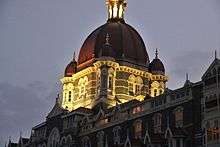
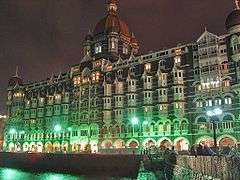
.jpg)


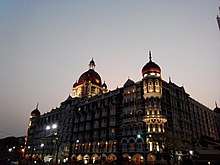
See also
References
- ↑ Category: Heritage Grand
- ↑ Letters from a Life: The Selected Letters and Diaries of Benjamin Britten, 1913-1976, Volume 4 Editors Philip Reed, Donald Mitchell, Mervyn Cooke, Boydell Press, 2008 pp. 379
- ↑ Shree 420 - Raj Kapoor, Nadira and Lalita Pawar - Bollywood Evergreen Movie, Shemaroo, Oct 30, 2014, location 1:01:28
- ↑ Sports Car Market magazine - February 2009 Publisher Keith Martin
- ↑ Vantage Asia Editor. "Trademarking the Taj". Vantageasia.com. Retrieved 2018-06-02.
- ↑ Jun 19, 2017 11:33 IST (2017-06-19). "Mumbai's Taj Palace becomes first Indian building to get trademark - IBTimes India". Ibtimes.co.in. Retrieved 2018-06-02.
- ↑ "Mumbai's Taj Mahal Palace hotel acquires image trademark". The Indian Express. Retrieved 2018-06-02.
- ↑ Barack Obama's Indian delegation 'books 800 rooms in Mumbai' Philip Sherwell, The Telegraph, 24 Oct 2010
- ↑ ‘Panama Peppers:’ The restaurants in India that only those with great tax shelters can afford, Quartz, April 08, 2016
- ↑ OFF THE SHELF, Tragic love story, Reviewed by V. N. Datta, Tribune India, November 21, 2010
- ↑ Allen, Charles (3 December 2008). "The Taj Mahal hotel will, as before, survive the threat of destruction". The Guardian. London. Retrieved 24 May 2010.
- ↑ Gray, Sadie (27 November 2008). "Terrorists target haunts of wealthy and foreign". The Guardian. London. Retrieved 24 May 2010.
- ↑ A monument to love – Mumbai’s Taj Mahal, The Hindu November 29, 2008
- ↑ 10 things to know about the Taj Mahal Palace Hotel, Rachel Lopez, Vogue, January 5, 2012
- ↑ OFF THE SHELF, Tragic love story, Reviewed by V. N. Datta, Tribune India, November 21, 2010
- ↑ Last Batch Of Troops Leave India (1948), British Pathé, Apr 13, 2014
- ↑ ELong gone blues, Live Mint, Dec 03 2011
- ↑ Taj Mahal Foxtrot: The Story of Bombay's Jazz Age, November 16, 2012, Naresh Fernandes Roli Books
- ↑ Shyamal Majumdar. "The story of Taj | Business Standard News". Business-standard.com. Retrieved 2018-06-02.
- ↑ Credits (2008-08-31). "AD Hotels: The Taj Mahal Palace Tower Photos". Architectural Digest. Retrieved 2018-06-02.
- ↑ Foster, Peter (2008-11-27). "Bombay terror attacks: Why the Taj Mahal Hotel was chosen". Telegraph. Retrieved 2018-06-02.
- ↑ Ramesh, Randeep (27 November 2008). "Dozens still held hostage in Mumbai after a night of terror attacks". London: The Guardian. Retrieved 28 November 2008.
- ↑ Mumbai 26/11 terror attack- Taj Mahal hotel under siege TIMES NOW Nov 25, 2014
- ↑ "Terror in Mumbai". YouTube. 2014-01-21. Retrieved 2018-06-02.
- ↑ "Timeline: Mumbai under attack". BBC News. 1 December 2008. Retrieved 3 December 2008.
- ↑ "Taj Mahal Hotel chairman: We had warning". CNN. 29 November 2008. Retrieved 6 September 2013.
- ↑ Pasricha, Anjana (21 December 2009). "Mumbai's Attacked Hotels Reopen". Voice of America. Retrieved 22 December 2008.
- ↑ Mohammed, Arshad (18 July 2009). "Clinton meets Mumbai victims, serenaded by artisans". Reuters. Mumbai.
- ↑ HNN Newswire
- ↑ "Obama visits site of Mumbai attacks, praises India's resilience". Los Angeles Times. Retrieved 4 July 2011.
- ↑ http://www.timeoutmumbai.net/film/dvd-reviews/taryanche-bait
- ↑ Leadbeater, Chris (26 August 2014). "Hotel India: Mumbai's Taj Mahal Palace leaves its darker days behind". The Independent. Retrieved 28 August 2014.
External links
| Wikimedia Commons has media related to Taj Mahal Palace Hotel. |
